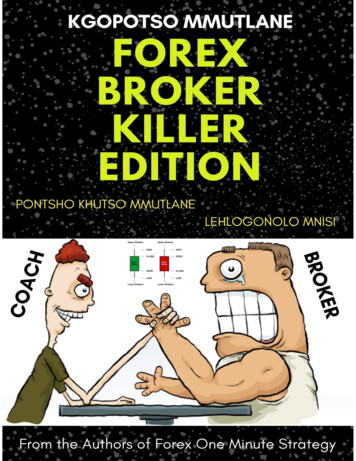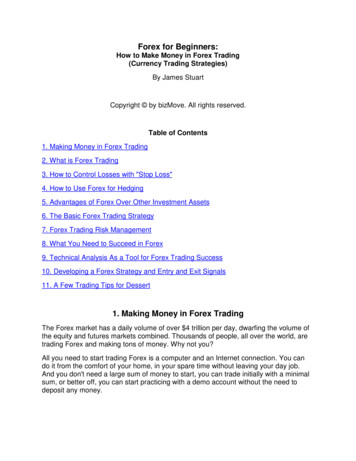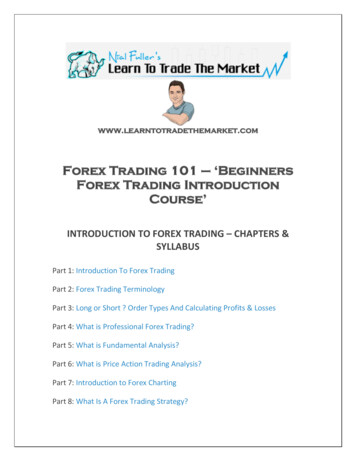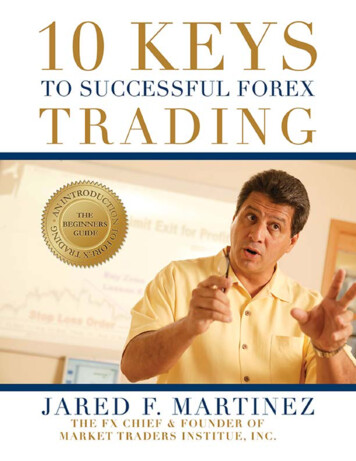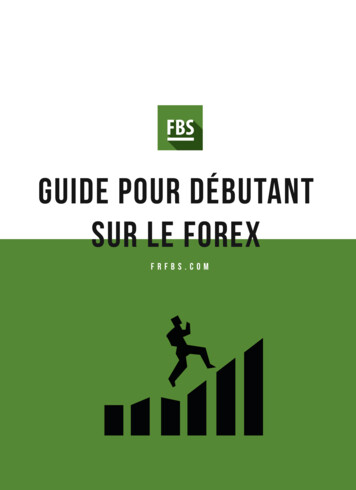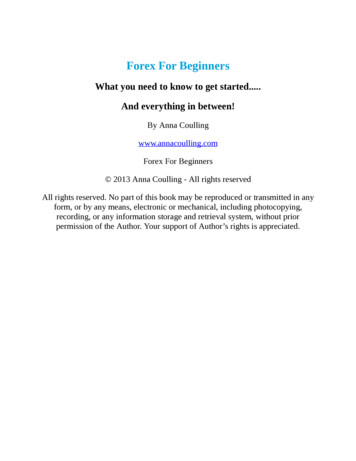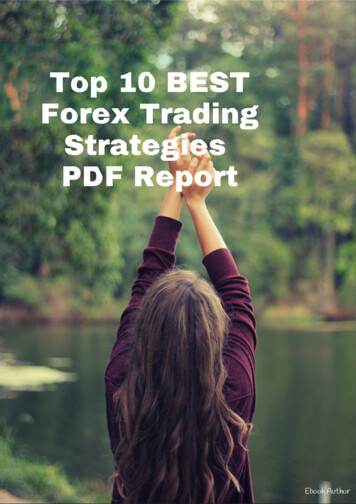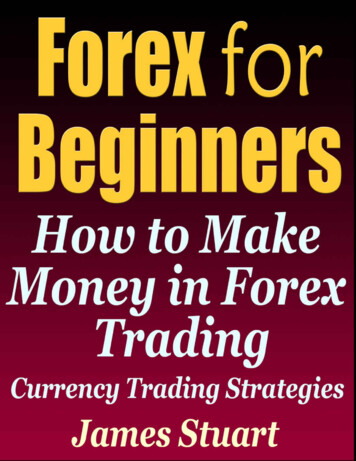
Transcription
Forex for Beginners:How to Make Money in Forex Trading(Currency Trading Strategies)By James StuartWatch Our New Free VideoRevealed At Last! The Best Kept Secret Among Successful ForexTradersThe Easiest Way to Make Money in Forex and CFD
Copyright Liraz Publishing. All rights reserved.
Table of Contents1. Making Money in Forex Trading2. What is Forex Trading3. How to Control Losses with "Stop Loss"4. How to Use Forex for Hedging5. Advantages of Forex Over Other Investment Assets6. The Basic Forex Trading Strategy7. Forex Trading Risk Management8. What You Need to Succeed in Forex9. Technical Analysis As a Tool for Forex Trading Success10. Developing a Forex Strategy and Entry and Exit Signals11. A Few Trading Tips for Dessert
1. Making Money in Forex TradingThe Forex market has a daily volume of over 4 trillion per day, dwarfing thevolume of the equity and futures markets combined. Thousands of people, allover the world, are trading Forex and making tons of money. Why not you?All you need to start trading Forex is a computer and an Internet connection.You can do it from the comfort of your home, in your spare time withoutleaving your day job. And you don't need a large sum of money to start, youcan trade initially with a minimal sum, or better off, you can start practicingwith a demo account without the need to deposit any money.Once you consider to start Forex trading, one of the first things you need todo is choose a broker, choosing a reliable broker is the single most criticalfactor to Forex success.There are dozens of online brokers out there but your best bet is to go withthe leader.Based on our experience, The best online FX broker for beginners and prosalike is e-Toro (If the link doesn't work, copy and paste the following URLinto a browser: www.liraz.com/etoro). Why? for starters this broker is ratedamong the best in trading quality, security, bonuses, payout and experience.More than that, e-Toro is much more than a simple Forex broker, it is a"social network" that allows you to copy the trading strategies of thenetwork’s best traders (according to the company, over 85% of copied tradeson e-Toro are profitable). You have to see it to believe it. Unfortunately, thisbroker does not accepts US residents.Now I would strongly encourage you to go and visit the above broker's siteright now even if you are not yet decided whether you want to go into Forextrading. Why? because it provides tons of free education materials, videosand best of all a demo account that allows you to practice Forex trading forfree without the need to deposit any money. Simply go to the site, register fora free account and start "trading" - by actually practicing and experiencing itfirsthand you'll be able to decide whether Forex trading is for you.In any case, before starting to trade for real, it is advisable that you practice
with a demo account. Once you build some skill and feel more comfortablewith the system you can start trading gradually for real money.Go to Top
2. What is Forex TradingForeign exchange, popularly known as 'Forex' or 'FX', is the trade of a singlecurrency for another at a decided trade price on the over-the-counter (OTC)marketplace. Forex is definitely the world's most traded market, having anaverage turnover of more than US 4 trillion each day.Compare this to the New York Stock Exchange, that has a daily turnover ofabout US 70 billion and it is very obvious how the Forex market is definitelythe largest financial market on the globe.In essence, Forex currency trading is the act of simultaneously purchasingone foreign currency whilst selling another, mainly for the purpose ofspeculation. Foreign currency values increase (appreciate) and drop(depreciate) towards one another as a result of variety of factors such aseconomics and geopolitics. The normal objective of FX traders is to makemoney from these types of changes in the value of one foreign currencyagainst another by actively speculating on which way foreign exchange ratesare likely to turn in the future.In contrast to the majority of financial markets, the OTC (over-the-counter)currency markets does not have any physical place or main exchange andtrades 24-hours every day via a worldwide system of companies, financialinstitutions and individuals. Because of this, currency rates are continuouslyrising and falling in value towards one another, providing numerous tradingchoices.One of the important elements regarding Forex's popularity is the fact thatcurrency trading markets usually are available 24-hours a day from Sundayevening right through to Friday night. Buying and selling follows the clock,beginning on Monday morning in Wellington, New Zealand, moving on toAsian trade spearheaded from Tokyo and Singapore, ahead of going toLondon and concluding on Friday evening in New York.The fact that prices are available to deal 24-hours daily makes certain thatprice gapping (whenever a price leaps from one level to another with notrading between) is less and makes sure that traders could take a position eachtime they desire, irrespective of time, even though in reality there are
particular 'lull' occasions when volumes tend to be below their daily averagewhich could widen market spreads.Forex is a leveraged (or margined) item, which means that you are simplyrequired to put in a small percentage of the full value of your position to set aforeign exchange trade. Because of this, the chance of profit, or loss, fromyour primary money outlay is considerably greater than in conventionaltrading.Currencies are designated by three letter symbols. The standard symbols forsome of the mostcommonly traded currencies are:EUR – EurosUSD – United States dollarCAD – Canadian dollarGBP – British poundJPY – Japanese YenAUD – Australian dollarCHF – Swiss francForex transactions are quoted in pairs because you are buying one currencywhile selling another. The first currency is the base currency and the secondcurrency is the quote currency.The price, or rate, that is quoted is the amount of the second currencyrequired to purchase one unit of the first currency. For example, if EUR/USDhas an ask price of 1.2327, you can buy one Euro for 1.2327 US dollars.There are so-called majors, for which around 75% of all market operations onForex are held: the EUR/USD, GBP/USD, USD/CHF, and USD/JPY. As wesee, the US dollar is represented in all currency pairs, thus, if a currency paircontains the US dollar, this pair is considered a major currency pair. Pairswhich do not include the US dollar are called cross currency pairs, or crossrates. The following cross rates are the most actively traded:EUR/CHF euro-franc
EUR/GBP euro-sterlingEUR/JPY euro-YenGBP/JPY sterling-YenAUD/JPY aussie-YenNZD/JPY kiwi-YenTo give you a taste of what is happening in the Forex arena here are somehistorical Forex events.One of the most interesting movements in the Forex market involving theBritish pound took place in the September 16, 1992. That day is known asBlack Wednesday with the British Pound posting its biggest fall. It wasmostly seen in the GBP/DEM (British Pound vs. the Deutschemark) and theGBP/USD (British Pound vs. the US dollar) currency pairs.The fall of the British pound against the US dollar in the period fromNovember to December 1992 constituted 25% (from 2.01 to 1.51 GBP/USD).The general reasons for this "sterling crisis" are said to be the participation ofGreat Britain in the European currency system with fixed exchange ratecorridors; recently passed parliamentary elections; a reduction in the Britishindustrial output; the Bank of England efforts to hold the parity rate for theDeutschemark, as well as a dramatic outflow of investors. At the same time,due to a profitability slant, the German currency market became moreattractive than the British one. All in all, the speculators were rushing to sellpounds for Deutschemarks and for US dollars. The consequences of thiscurrency crisis were as follows: a sharp increase in the British interest ratefrom 10% to 15%, the British Government had to accept pound devaluationand to secede from the European Monetary System. As a result, the poundreturned to a floating exchange rate.Another intriguing currency pair is the US dollar vs. the Japanese Yen(USD/JPY). The US dollar and Japanese Yen is the third on the list of mosttraded currency pairs after the EUR/USD and GBP/USD. It is traded mostactively during sessions in Asia. Movements of this pair are usually smooth;the USD/JPY pair quickly reacts to the risk peaking of financial markets.From the mid 80's the Yen ratings started rising actively versus the US
Dollar. In the early 90's a prosperous economic development turned into astandstill in Japan, the unemployment increased; earnings and wages slid aswell as the living standards of the Japanese population. And from thebeginning of the year 1991, this caused bankruptcies of numerous financialorganizations in Japan. As a consequence, the quotes on the Tokyo StockExchange collapsed, a Yen devaluation took place, thereafter, a new wave ofbankruptcies among manufacturing companies began. In 1995 a historicallow of the USD/JPY pair was recorded at -79.80.The above started an Asian crisis in the years1997-1998 that led a Yen crash.It resulted in a tumble of the Yen-US dollar pair from 115 Yens for one USdollar to 150.The global economic crisis touched almost all fields of human activities.Forex currency market was no exception. Though, Forex participants (centralbanks, commercial banks, investment banks, brokers and dealers, pensionfunds, insurance companies and transnational companies) were in a difficultposition, the Forex market continues to function successfully, it is a stableand profitable as never before.The financial crisis of 2007 has led to drastic changes in the world'scurrencies values. During the crisis, the Yen strengthened most of all againstall other currencies. Neither the US dollar, nor the euro, but the Yen provedto be the most reliable currency instrument for traders. One of the reasons forsuch strengthening can be attributed to the fact that traders needed to find asanctuary amid a monetary chaos.Ask and BidWhen traders want to place an order on the Forex market they should beaware of the currency pair as well as the price of this pair. A Forex marketprice of a currency pair is denoted by two symbols, Ask and Bid, which havespecific digital notations.Ask price is the highest price in the pair’s quotation at which a trader buysthe currency, standing first in the abbreviation of the currency pair.Consequently, a trader sells the currency standing second.Bid price is the lowest price in the quotation of the currency pair, at which atrader sells the currency standing first in the abbreviation of the currency pair.
Respectively, a trader buys the currency standing second.Seem complicated? here's an example:Let's assume that we have the currency pair of EUR/USD with the quotationof 1.3652/1.3655. This means that you can buy 1 euro for 1.3655 dollars or tosell 1 euro for 1.3652 dollars. The difference between the Bid price and theAsk price is called spread.The spread is actually the commission of the broker. The Spreads in Forextrading are actually very small compared to currency spreads at banks.A term that you'll see a lot while trading Forex is "pip" and "pips" - a “pip”stands for “Percentage in Point”. A pip is the smallest price movement of atraded currency. It is also referred to as a “point”. It is very important thatyou understand what a pip is in the Forex trading because you will be usingpips in calculating your profits and losses. For most currencies a pip is0.0001 or 1/100 of a cent.When a currency moves from a value of 1.2911 to 1.2914, it moved 3 pips.When a pip has a value of 10, you have gained 30.There is an exception for quotations for Japanese Yen against othercurrencies. For currencies in relation to Japanese Yen a pip is 0.01 or 1 cent.Another term that you'll need to understand in relation to Forex trading is“Lots”. A lot is the minimal traded amount for each currency transaction. Forregular accounts one lot equals 100,000 units of the base currency. Howeveryou can also open mini and micro accounts that allow trading in smaller lots.Understanding the Pip Spread - The spread is closely associated with thepip and has a major importance for you as a trader. As mentioned above, It isthe difference between the selling and the buying price of a currency pair. Itis the difference in the bid and ask price. The ask is the price at which youbuy and the bid is the price at which you sell.Suppose the EUR/USD is quoted at 1.4502 bid and 1.4505 ask. In this casethe spread is 3 pips. The pip spread is your cost of doing business here. In thecase above it means you sustain a paper loss equal to 3 pips at the momentyou enter the trade. Your contract has to appreciate by 3 pips before youbreak even. The lower the pip spread the easier is it for you to profit.
Generally the more active and bigger the market, the lower the pip spread.Smaller and more exotic markets tend to have a higher spread. Most brokerswill be offering different spreads for different currencies. Smaller accountswill generally have higher spreads than bigger regular accounts.From the profitability point of view it is important to find a broker offering alower pip spread, however the low spread is not everything. More importantis to choose a reputable and reliable broker.Most brokers will allow leverage. Leverage is defined as the use of borrowedcapital, such as “margin” allowing the trader to gain access to larger sums ofcapital. This can heighten profits and losses and should be used wisely.Here's an example: Trader A has 5000 USD – If Trader A has an accountleverage of 10:1 and he wishes to use 1000 on one trade as margin, he willhave an exposure of 10,000 in base currency ( 1000) 10 x 1000 10,000 (trade value).Trader B has 5000 USD – If Trader B has an account leverage of 100:1 andhe wishes to use 1000 on one trade as margin, he will have exposure of 100,000 in base currency ( 1000) 100 x 1000 100,000 (trade value).Go to Top
3. How to Control Losses with "Stop Loss"Stop loss is a widely used order aiming mainly at limiting the possible lossesin case of negative market movements.Stop loss is used only with open positions. When the market conditions arenot favorable for a trader and the price has reached the level of the "Stoploss", the deal is closed automatically. Therefore, Stop loss helps the trader tocontrol losses and in case of failures to keep safe at least part of his deposit.If a trader does not use Stop loss orders, the position is closed by the brokerwhen the sum of losses is equal to the sum of the deposit.There are 3 types of Stop loss orders: fixed Stop loss, sliding Stop loss andcombined Stop loss.Fixed Stop losses are set while opening positions. They cannot be changeduntil the deal is closed. Sliding stop losses, on the other hand, can bemodified any time depending on the price movement. Another name forsliding Stop loss is Trailing stop, that can be modified either manually orautomatically based on the traders' settings.There are many discussions on whether it is necessary to use Stop losses ornot. Some traders believe that Stop loss is essential in trading, emphasizingthe ability of Stop losses to prevent the loss of the whole deposit. If the priceis rapidly moving in a direction which does not correspond to the forecast, adeal that has not been closed in time can result in a significant loss. Theopponents of Stop loss believe that this order can limit not only losses, butprofits as well. Since price movements are often unpredictable andunexpected, they can develop in line with the trader’s expectations, thoughwith some periodic bounces crossing the Stop loss line. In this case theposition is closed prematurely with a loss while it could develop into a profitlater on.As a rule, the decision on whether to use Stop loss or not depends on theindividual strategy and preferences of a particular trader.Trailing stop is an order which its major function is to act as an automaticmaintenance of an open position with continually shifting of the stop loss
level depending on the price movement.A trader may open a bullish position and sets the gap from the current priceto trailing stop in pips. When the price goes upwards, the trailing stop followsit automatically sticking to the set gap. In case that the price goes down, thenthe trailing stop quote remains on the spot. In this way, a trader using atrailing stop has an opportunity to derive maximal profit at an ascending pricewith no regard to the set Take Profit value. Furthermore, a trailing stop is aloss limiter.Here is an example: a trader opens a buy position at the price of 1.3400 andputs the trailing stop value at 50 pips back, i.e. at 1.3350. In case that theprice starts to move upwards and exceeds the mark of 1.3400, the trailingstop follows it automatically keeping the set gap of 50 pips from the currentprice. That means, if the price touches 1370, the trailing stop shifts to 1320. Ifthe price turns down, the price does not change its position.As to a sell position opening, trailing stop behaves quite in the opposite. Thetrader sets it a few pips higher. At a price descending motion the trailing stopshifts according to the set size. With the up-going price, the trailing stop doesnot move.While applying a trailing stop in Forex operations a trader will have toremove stop loss orders manually in line with increases in the trade profit.Trailing stop sets a stop loss level automatically at the value the trader needs.A trailing stop is mainly used by traders who run trend trading, but can'tfollow the price moves continually. Trailing stop usage is also feasible atintraday trades, when quick reaction to price change is required.Please note that trailing stops work only when the trading terminal is open.Once the terminal is switched off the stop loss is fixed at its current spot.Go to Top
4. How to Use Forex for HedgingHedging denotes safety and security. Hedging means the protection of aclient's funds from unfavorable currency rate fluctuations. Account funds arefixed at their current price through conducting trades on Forex. Thus, hedginghelps to ease exposure to currency rate changes risks, which helps to preventthe risk of currency rate fluctuations.As a matter of fact, hedging presupposes using one instrument in order tolower the risk related to unfavorable market factors impact on the price ofanother one directly associated with it. In most cases, the notion of ‘hedging’means insurance from currency price fluctuations, assets etc. Hedging canalso be considered as a type of investment allowing to minimize pricemovements risks in the market. The hedging cost should be valued withregard to the possible losses in the event of not hedging.Hedging types in ForexOne type of hedging is protecting the buyer’s money by lowering the risk of apossible increase of an instrument price. Another type is hedging the seller’smoney in order to lower a price drop risk.Here's a hedging example: a trader, who imports in a foreign currency, opensa buy trade with the currency of his trading account in advance, and when thereal time of the currency purchase arrives to his bank, he closes the position.And a trader, who exports in a foreign currency, opens a sell trade with thecurrency on his trading account beforehand, and at a the real moment of thiscurrency purchase in his bank, he closes it.Go to Top
5. Advantages of Forex Over Other Investment Assets1. Simple to comprehend and master - In a Forex trade we deal with just apair of currencies2. Low Minimum Investment - The Forex market requires less capital tostart trading than most other markets. The initial investment could go verylow, depending on the leverage offered by the broker. This is a greatadvantage since Forex traders are able to keep their risk investment to thelowest level. Online Forex brokers offer "mini" and "micro" trading accountswith low minimum account deposit.We're not saying you should open an account with the bare minimum, but itdoes make Forex trading much more accessible to the average individual whodoesn't have a lot of start-up trading capital.3. 24 Hour Market - Since the Forex market is worldwide, trading iscontinuous as long as there is a market open somewhere in the world.Trading starts when the markets open in Australia on Sunday evening, andends after markets close in New York on Friday.4. High Liquidity - Liquidity is the ability of an asset to be converted intocash quickly and without any price discount. In Forex this means we canmove large amounts of money into and out of foreign currency with minimalprice movement.5. Low Transaction Cost - In Forex, typically the cost of a transaction isbuilt into the price. It is called the spread. The spread is the differencebetween the buying and selling price.6. Leverage - Forex Brokers allow traders to trade the market using leverage.Leverage is the ability to trade more money on the market than what isactually in the trader's account. If you were to trade at 50:1 leverage, youcould trade 50 on the market for every 1 that was in your account. Thismeans you could control a trade of 50,000 using only 1000 of capital.7. Profit Potential from Rising and Falling Prices - The Forex market hasno restrictions for directional trading. This means, if you think a currencypair is going to increase in value; you can buy it, or go long. Similarly, if you
think it could decrease in value you can sell it, or go short.8. No one can corner the market - The foreign exchange market is so hugeand has so many participants that no single entity can control the market pricefor an extended period of time.9. Forex is the largest financial market in the world - The Forex markethas a daily volume of over 4 trillion. Such a huge amount of a daily volumeallows for an excellent price stability in most market conditions. This meansyou likely will never have to worry about slippage as you would whentrading stocks or commodities. The price you see quoted on your tradingscreen is the price you get.10. Market transparency and Instant execution - Market transparency ismuch greater in Forex than in stocks or commodities, this means it is easier toanalyze the inner workings of the market and figure out what is driving it. Forexample, economic reports and news announcements that drive a country’seconomic policy are widely available and accessible for anyone interested.Whereas an individual company’s accounting statements are much harder ifnot impossible to obtain. Instantaneous order execution is another greatadvantage Forex has over other markets. Retail Forex trading is generallydone over the internet on all electronic platforms. The Forex market has nocentral exchange and was designed to be this way to facilitate large banks andallow for instant execution of transactions, this means no delays for you andextreme ease of execution.11. Price movements are highly predictable in the Forex market - Due toits highly speculative nature Forex price movements tend to over shoot andthen correct back to the mean. This means there are a number of repetitivepatterns that are easily recognizable to the trader who is trained in priceaction analysis. Forex currency pairs generally spend more time in verystrong up or down trends than other markets, this is also a huge advantagebecause it is generally much easier to trade a strongly trending market than achaotic and consolidating market.12. No constraints on the number or type of transactions - The futuresmarket sometimes will have what is called a “limit up” or a “limit down” day,this means when the price moves beyond a pre-determined daily level traders
are restricted from entering new positions and are only allowed to exitexisting positions if they desire to do so. This is meant to control volatility,but because the futures market for currencies follows the spot Forex marketthe next day at the futures open their sometimes will be large “gaps” or areaswhere the price has adjusted over night to match the current spot Forex price.Now, if you were holding a futures position over night it is entirely possiblethat your stop got gapped around, in which case you would get filled at thenext best price, which often will be extremely damaging to your tradingaccount. Due to the 24 hour nature of the spot Forex market even in extrememarket volatility traders generally don’t have to worry about gaps and canalmost always get out at the exact price they want.13. Direct participation, difficult to manipulate or influence - Forextrading operates in a decentralized online electronic market for itsparticipants: Banks, FCMs, hedge funds, governments, retail currencyconversion houses and high worth net individuals. There is no middlemanbetween the trader and buyer/seller. Investors can interact directly with themarket maker for pricing on a currency pair. Access is quicker and costs arelower than in other markets. Large market liquidity makes it very difficult forany one participant to manipulate or influence it.14. Easier market analysis - Countries are more often stable than companiesmaking it easier to predict their economic direction. Primary factors affectingdemand and supply for Forex investment are interest rates and economicindicators such as GDP, trade balances and foreign investment. This andother economic data released regularly determines demand and supply forcurrency pairs.15. Technology frontiers and investing - Technology enables the retailinvestor the ability to make better investment decisions through ready accessto economic and political news events, to technical charting software andelectronic trading platforms. They also have transparent and safe access totheir investment funds in segregated accounts so that the safety of their fundsis guaranteed.16. Limited Risk - Despite the common perception about Forex being risky,it is easy to limit and reduce the risk if a trader chooses the right strategy. In
addition it should be mentioned that stops are much easier to control as well,that is why newbies have good chances to succeed even while doing theirfirst steps as Forex investors and traders.17. No fees or middlemen - There are no commissions when trading on theForex market. The retail brokers in this market are compensated through thebid-ask spread. Businessmen can also spot currency trading which eliminatesthe middlemen and allows each person to trade directly with the market thatis responsible for pricing on a certain currency pair. Not only does thisexpedite the process, it gives each trader more options and versatility.Go to Top
6. The Basic Forex Trading StrategyThe basic Forex strategy that is used by many traders of all experience levels,is Trend Following. This strategy is widely followed because of its simplicityto identify and trade and many times, strong trends can bail you out of animperfect set of buy and sell rules.A popular trading express is “the trend is your friend.” This expression hasstood the test of time because many traders find it to be a critical buildingblock of a trading plan. Before we delve into the basics of Trend Following,it is important to first explain why trend trading is a popular strategy used bymany new and experienced traders.Do you have the perfect Forex trading strategy? I have not found it. To me, aperfect strategy is the one that wins all of the time and has minimal tradedrawdown. I hate to burst your bubble but a 100% win ratio strategy does notexist.Therefore, learning how to trade in an imperfect world is very important.Trend following is a simple way to cover up some strategy imperfections byidentifying the strongest trends in the market.For example, if the market is moving up in a strong trend, it isn’t as importantwhat the strategy is used to time entries, you simply need to be buying. Whenyou trade in the direction of the trend, the rest of your trading approach canfall right into place. This doesn't mean that all your trades will be winners. Itdoes mean that you don't have to be exact in your entries and exits once youfind a strong trend to trade.Now how do you know when a trend starts and when it is going to end? thisis the 64,000 question. Since this is a beginners guide I will not elaborate onthe various techniques that traders use to identify trends as this is beyond thescope of this book. I will however touch on several techniques in laterchapters but note that these will be just in an introduction level without goingtoo much deeper.Any trader either a newbie or a pro should develop his own style of trading.There are several trading styles that you can adopt. You will choose your
style based on your personality and financial capacities.Many traders make the mistake of adopting a trading style that is unnaturalfor them. A trader may adopt one of the following two main trading styles:Day Trading and Intraweek trading. Let's discuss each of them;Day TradingDay trading on Forex means that one or few trades are conducted within onetrading day. As a rule, the time intervals between the opening or the closingof trades may take from several minutes up to several hours.Despite some difficulties of day-trading, this type of trading is very popularamong the newcomers as well as among experienced traders. Day tradingallows for the opportunity to make a profit in a short time with a smallamount of funds.In order to achieve favorable results in an intraday trading it is essential thatyou make the right forecast as to the price movement, as there are manyexternal factors that cause high volatility in the currency market. So to makeyour day trading beneficial you have to track the market situation, collatefacts and make conclusions about the price behavior
1. Making Money in Forex Trading 2. What is Forex Trading 3. How to Control Losses with "Stop Loss" 4. How to Use Forex for Hedging 5. Advantages of Forex Over Other Investment Assets 6. The Basic Forex Trading Strategy 7. Forex Trading Risk Management 8. What You Need to Succeed in Forex 9. Technical Analysis As a Tool for Forex Trading .
